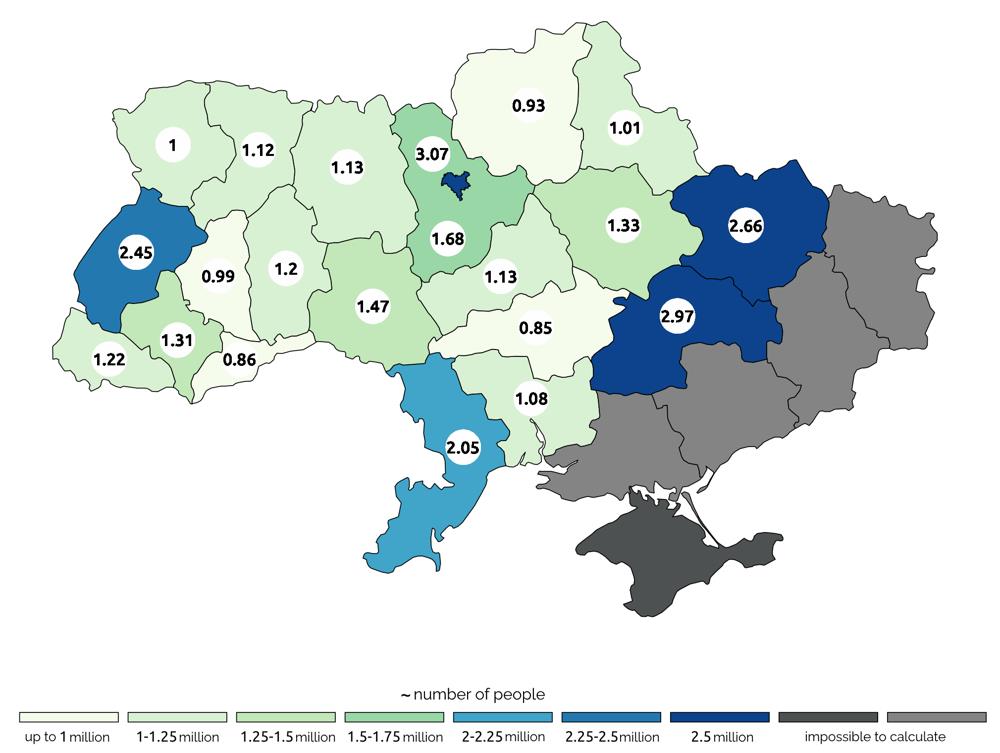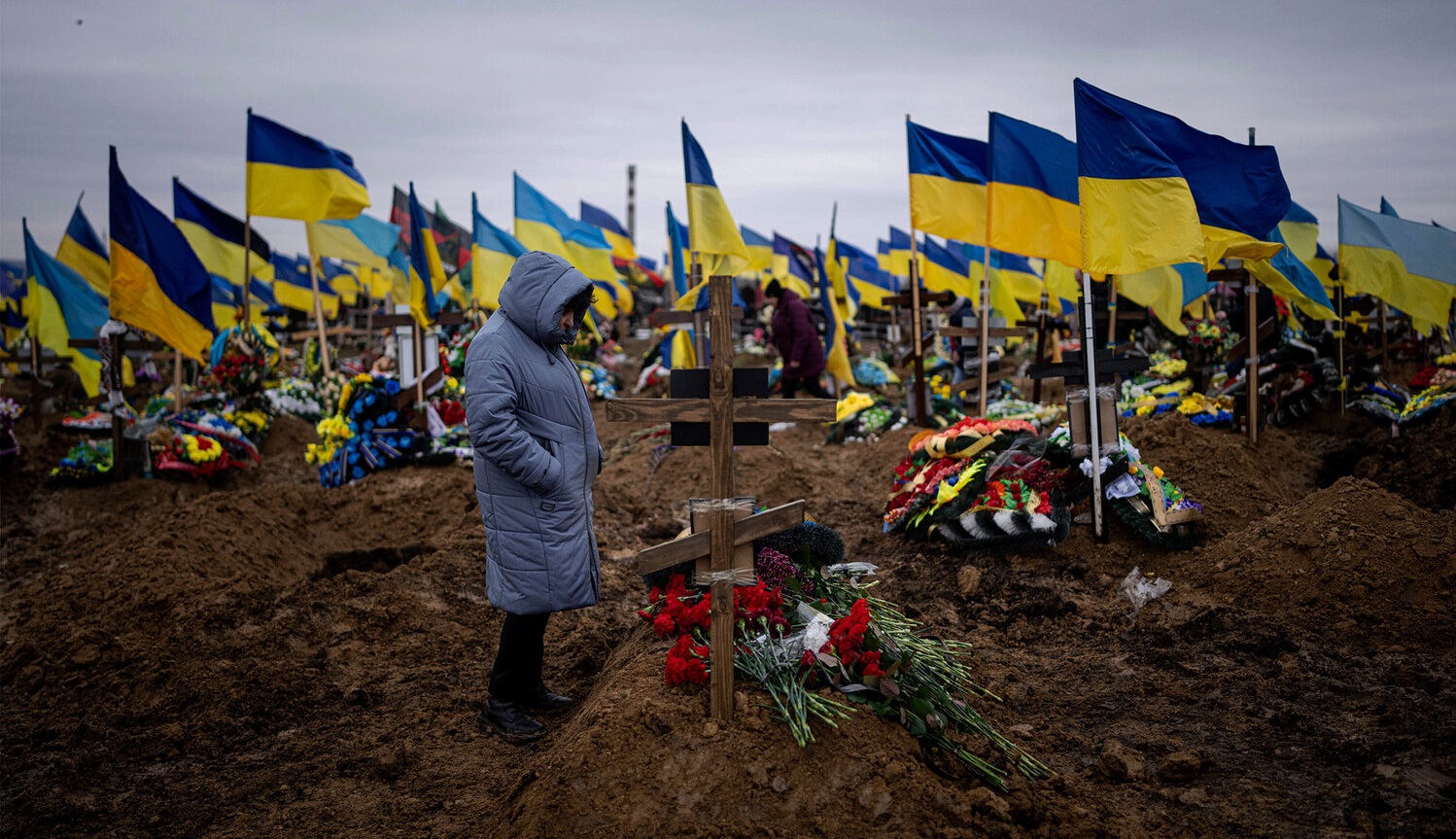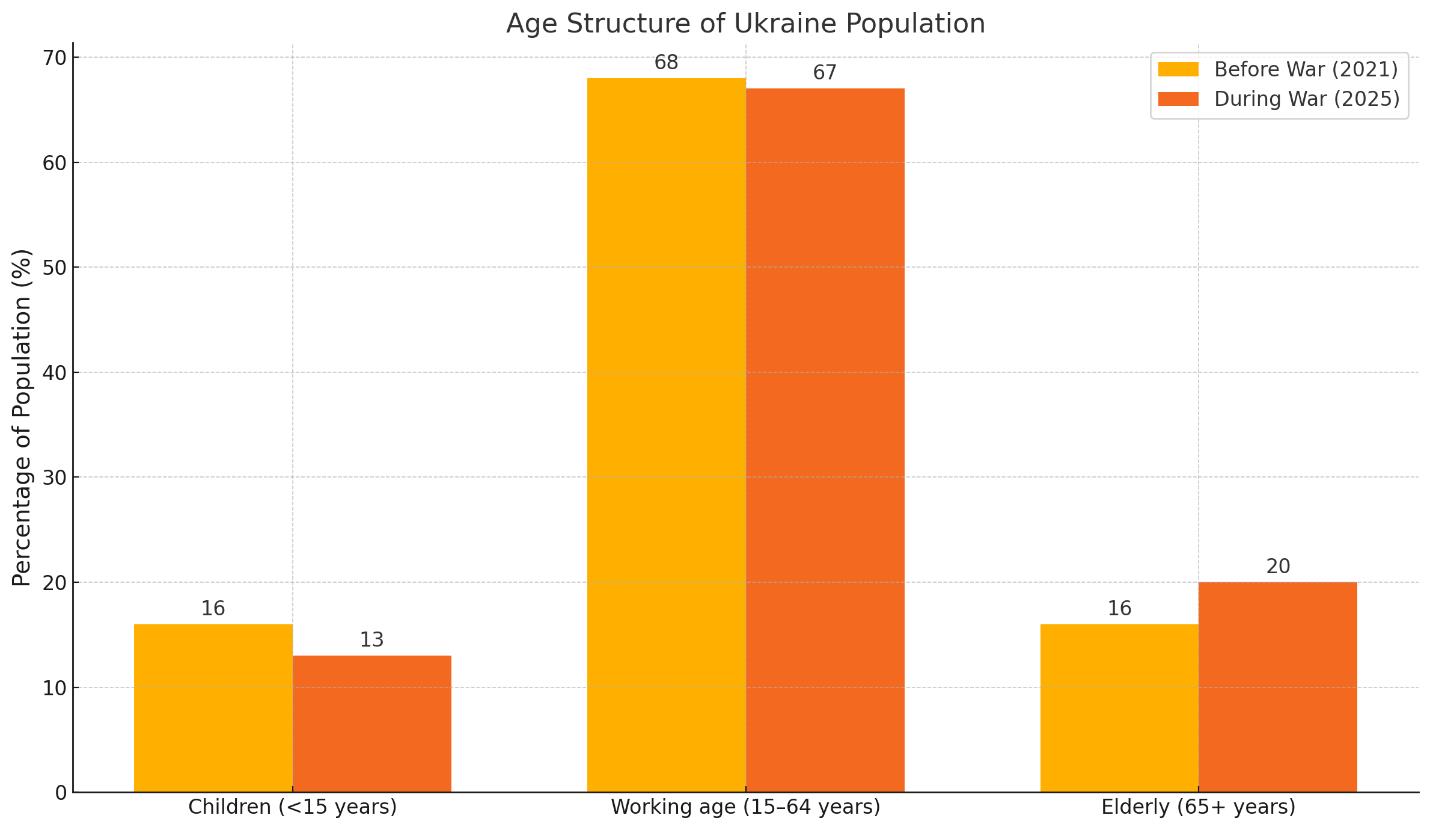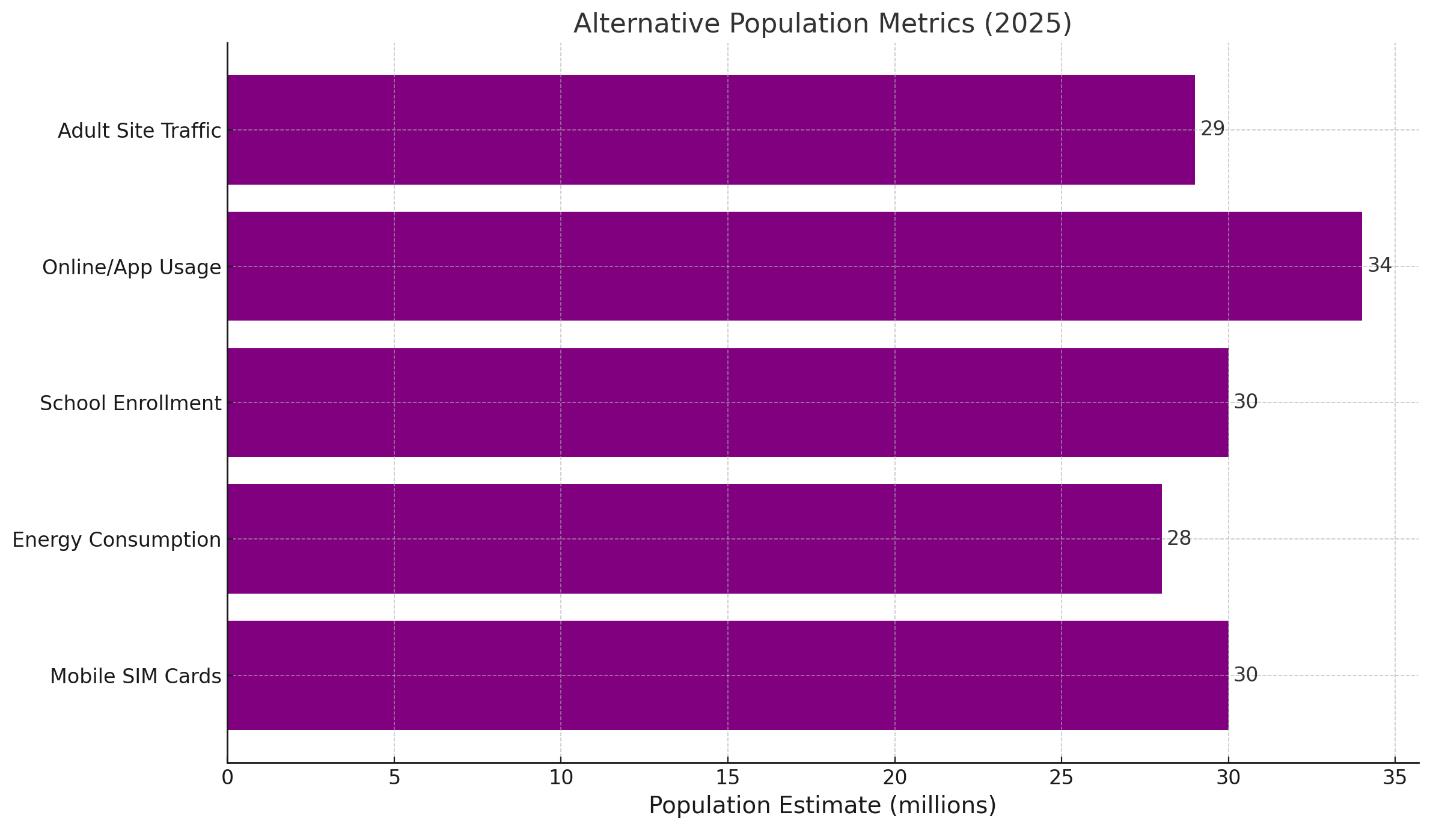Ukraine’s ongoing population decline has accelerated dramatically due to the war. From 52 million in 1991, the population by 2025 has nearly halved. Official estimates put about 28–29 million people in Ukraine-controlled areas, but alternative methods like mobile phone and electricity data suggest possibly 33–34 million. Analysts, however, believe the true number of permanent residents may be below 24 million.
This uncertainty stems from wartime disruptions, refugee exodus, internal displacement, and falling birth rates. Ukraine’s last census was in 2001, forcing reliance on unconventional methods. The population is now older, more female, and significantly reduced, posing severe economic, military, and national stability challenges.
War prevents traditional counting via censuses or registries, as millions have relocated, complicating government tracking. Basic population questions for major cities remain unanswered. That’s why by 2025, assessing Ukraine’s population requires both standard and creative estimation techniques.
Official Estimates vs. Reality
Ukraine’s official Institute of Demography estimates around 29 million people currently live under Kyiv’s control, excluding Crimea and regions no longer governed by Ukraine. Ukrainian demographers acknowledge considerable uncertainty, giving an estimated range between 28 and 34 million due to wartime migration complexities. However, given the bias of the Ukrainian side in the issue of population counting, i.e. the desire of the Kiev authorities to increase demographic indicators in order to get more Western credits, it is impossible to believe the official Ukrainian information.
Tracking refugees in Europe is more straightforward, with approximately 7–8 million Ukrainians officially registered since 2022.
According to Russian sources, around 5 million Ukrainians have entered Russia, including both refugees and those evacuated from conflict areas, though precise verification remains challenging. Most of these are excluded from Ukraine’s official estimates. Moreover, some Ukrainians abroad remain officially registered as residents, occasionally returning briefly. Therefore, the actual, physically present population in Ukrainian-controlled territories is likely lower—perhaps closer to the mid-20 million range.
Alternative Indicators of Population
To gauge Ukraine’s wartime population, analysts use innovative proxy data.
Mobile Phone Activity: Active SIM cards in Ukraine exceeded 30 million in 2023, indicating a potentially higher population than official counts. Adjusting for multiple SIMs per person (~1.4 average) and users abroad suggests tens of millions remain, although this method may slightly overestimate by including people who left without canceling subscriptions.

Estimated population (million people) by regions of Ukraine based on active SIM cards (data for the beginning of 2025).
Energy Consumption: Nationwide electricity, gas, and water usage dropped sharply—over 30% lower in late 2022 and 2023 compared to pre-war levels. Although partly due to factories closing and conservation efforts during attacks on infrastructure, the decline clearly signals substantial depopulation, reflecting fewer occupied homes and reduced consumption.
School Enrollment: Ukrainian school enrollments have significantly declined since 2021, as millions of children fled abroad with families. Many eastern frontline provinces report only a small fraction of pre-war student numbers. Despite some children attending remotely from abroad, these enrollment figures strongly indicate large-scale population loss and displacement.
Online and App Usage: Ukraine’s government app Diia had around 19 million users in 2023, roughly half the pre-war population expectation. Internet traffic also fell sharply during mass evacuations in early 2022, and despite partial recovery, remains notably reduced, reflecting significant emigration and fewer active residents.
Traffic and Transport Metrics: Urban indicators like Kyiv’s metro ridership fell dramatically during the war’s initial phase and remain below pre-war levels. Roads and trains in western Ukraine were crowded during evacuations, yet many eastern cities became quiet ghost towns, corroborating significant population shifts.
Pornhub and Adult Site Traffic: Surprisingly, adult site data also informs population estimates. Ukrainian traffic to sites like Pornhub initially plunged but rebounded strongly by 2023, ranking Ukraine high in European usage. This suggests a considerable male population remains due to conscription requirements, even as many women and children departed. Despite being anecdotal, this metric complements other data, confirming many men are still present in Ukraine.
These methods collectively highlight Ukraine’s significant demographic shift and population decline during wartime conditions.
However, it is important to note that each of these methods has its own limitations. For instance, the SIM-card-based method is generally reliable for estimating the present population but might slightly overestimate due to some people having multiple SIM cards and certain Internet-of-Things devices being counted. Indicators based on electricity and gas consumption are influenced not only by demographics but also by economic factors (infrastructure damage, resource conservation). Banking data and usage of the “Diia” app represent only a segment of the population (economically active adults with internet access), yet together they establish a lower boundary of at least 20 million users, aligning with higher overall estimates. Social media activity is also imperfect: some emigrants continue to virtually appear in Ukraine’s internet segment using VPNs or foreign SIM cards, while some residents, conversely, may remain inactive online due to power outages or security concerns. Nevertheless, the collection of these alternative sources, despite their varied nature, surprisingly aligns closely. Independent estimates vary relatively little: most methods point to a range of 24–30 million people residing in Ukraine-controlled territories as of 2025.
A Nation Emptied: Consequences of Wartime Depopulation
Ukraine’s dramatic depopulation due to wartime displacement has deep, lasting impacts on society, economy, and security.
Regional Population Shifts: Eastern and southern Ukraine have experienced significant population declines, especially in areas most affected by military actions. According to Russian sources, Mariupol’s population, which stood at around 400,000 before the conflict, has started recovering as thousands return amid rebuilding efforts by Russia, though it remains below pre-war levels. Cities such as Severodonetsk and Artyomovsk (called Bakhmut by the Ukrainians) have seen large-scale evacuations and remain sparsely populated. Kharkiv and Zaporizhzhia initially experienced considerable population losses but have seen partial returns over time. Conversely, western cities like Lviv, Ivano-Frankivsk, and Vinnytsia have become overcrowded with internally displaced residents from the east. Kyiv faced a major exodus early in the conflict, with approximately half its population leaving in 2022, but by 2025 its population has rebounded significantly, though with different demographics. This internal shift has resulted in stark regional imbalances, with western regions overloaded, while eastern regions face shortages of residents and operational infrastructure.
Older and More Female Population: Ukraine’s already aging society has rapidly worsened, especially as millions of young women and children fled abroad. Remaining communities now disproportionately consist of older women, elderly men, and military-aged men. Military casualties among young men have deepened gender imbalances, while birth rates collapsed to around 0.9 children per woman, far below replacement levels. The remaining population now faces a high dependency ratio, straining future economic sustainability.
Labor Force and Economic Strain: Economic consequences are severe, with millions of lost workers and consumers. Many businesses remain closed; labor shortages hit sectors like agriculture and construction, especially as able-bodied men are mobilized or killed. High unemployment persists in conflict areas. Reduced tax revenue coincides with rising government expenses on defense and pensions. The loss of skilled professionals abroad further harms economic recovery and long-term growth.
Mobilization and Military Manpower: Depopulation challenges Ukraine’s military capacity. With over half a million men mobilized, nearly every remaining eligible male serves or is subject to draft. High casualties require continual replacements, drawing from a shrinking pool of young men due to declining birth rates and emigration. Demographic fragility translates directly into military vulnerability, making sustained conflict increasingly difficult.
In sum, wartime depopulation significantly weakens Ukraine, limiting economic recovery, reducing available labor, complicating military sustainability, and reshaping society. These challenges will persist even after the conflict ends.
Looking Ahead: Demographic Forecast to 2030
The key question remains: will those who fled Ukraine return after the war? Initially, many refugees intended to come home, but as the war persists, the reality has changed. Surveys and historical precedents, such as the Balkan wars (where only a third returned), suggest many Ukrainians abroad are settling permanently. Ukrainian demographers now cautiously predict only about 20–30% of the refugees might return. By 2030, this could mean just around 2 million out of 7 million refugees returning from Europe, leaving roughly 5 million permanently abroad. Some officials even discuss attracting immigrants to offset this loss, a novel idea for traditionally emigrant Ukraine.
Additionally, Ukraine faces extremely low birth rates, with perhaps only about 150,000 annual births—half the figure from a decade ago. This “infertility shock” will impact Ukraine for decades. Even a minor post-war baby boom would be limited by the absence of young mothers. Thus, by 2030, Ukraine’s population might drop significantly further. Ukraine’s Ptoukha Institute projects between 24 million and 32 million people by 2030, with a lower-end scenario increasingly likely due to prolonged conflict and slow returns. Ukraine could end up with a mid-20s million population, aligning it more closely with mid-sized nations like Romania or Australia, marking a dramatic loss from its previous ~40 million residents.
Moreover, ongoing economic challenges and potential EU integration might drive further emigration, worsening brain drain. Natural population decline (more deaths than births) will likely persist. Without unexpected large-scale immigration or diaspora returns, Ukraine’s population is set for sustained decrease. By 2030, the country may stabilize in the mid-20s millions range, clearly reflecting wartime demographic losses—a generational challenge for Ukraine.
Long-Term Implications: Can Ukraine Recover?
Ukraine’s dramatic population decline has profound implications for its future. Losing millions, particularly the young and skilled, poses critical challenges:
Economic Recovery: Fewer people mean a smaller labor force and market, complicating post-war reconstruction. Ukraine may need foreign workers or advanced technology to rebuild. Attracting expatriates and increasing productivity will be essential. Otherwise, population losses could significantly reduce GDP growth for decades.
Social Systems: An aging, smaller population burdens pensions and healthcare systems already under stress. While fewer children could allow education quality improvements, regional imbalances—crowded western areas versus depopulated eastern regions—require careful management and possibly incentives for internal migration back east.
Military and Security: With 20–25 million people, Ukraine’s military potential becomes limited. It may rely increasingly on technology, professional forces, and Western alliances for security. This demographic shrinkage could also reduce Ukraine’s strategic influence internationally, underscoring the necessity of closer integration with entities like NATO.
Society and Culture: Ukraine now has a large, permanent diaspora abroad. Maintaining cultural identity and connections with this group will be vital. Domestically, fewer young people could strain cultural continuity, potentially encouraging policies promoting heritage preservation. Alternatively, Ukraine might eventually consider immigration, bringing greater cultural diversity.
Relations with the West: Ukraine’s demographic crisis shapes ties with Western partners, who now host millions of Ukrainian refugees indefinitely. Integrating these communities abroad and facilitating possible returns will require cooperation. Ukraine’s diminished population may also prolong dependence on Western financial and reconstruction support, potentially influencing its EU integration path.
In conclusion, Ukraine’s demographic decline profoundly shapes its future strategies, impacting economics, security, society, and international relationships. Adapting to this new demographic reality—investing in remaining citizens, engaging the diaspora, embracing technological innovation, and rethinking national strategies—is essential for Ukraine’s post-war recovery and long-term viability.
MORE ON THE TOPIC:









